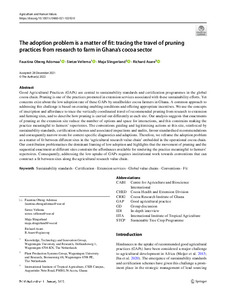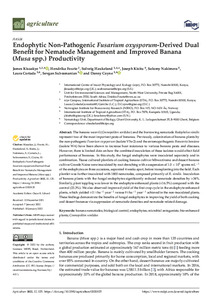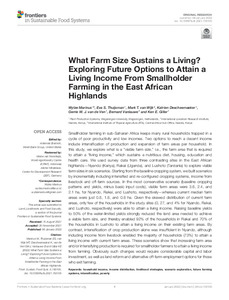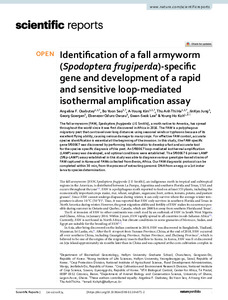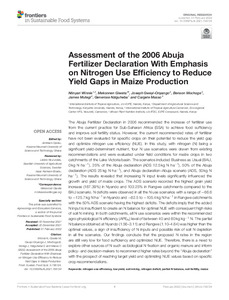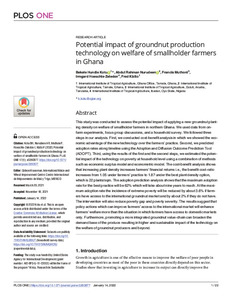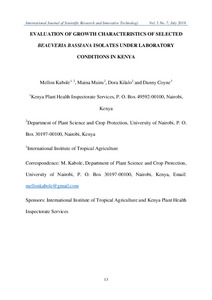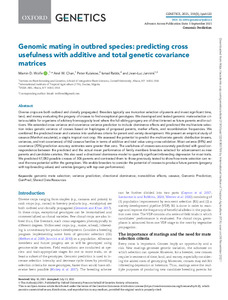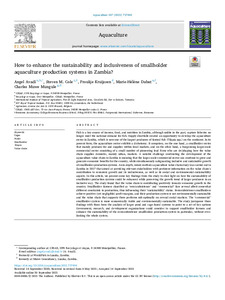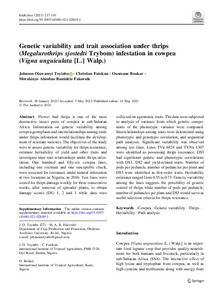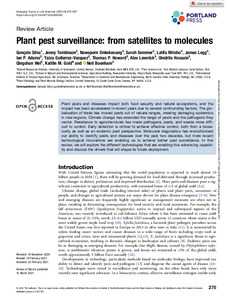Welcome to the International Institute of Tropical Agriculture Research Repository
Journal and Journal Articles: Recent submissions
Now showing items 781-800 of 5157
-
Systematics of Afrotropical Eristalinae (Diptera: Syrphidae) using mitochondrial phylogenomics
(2022-01-11)We examined the phylogeny and intrageneric classification of eristaline hoverfly genera from the Afrotropical Region using mitochondrial genomes. Genome skimming was used to obtain (nearly) full mtDNA and nuclear rDNA (18S, 28S) genomes of 120 museum vouchers from eight genera and 98 species. Phylogenetic reconstructions of mitogenomes and mitogenomes + nuclear rDNA yielded comparable phylogenies while that of rDNA only resulted in poorly resolved phylogenies. Phylogenetic analyses focused on six ... -
Effect of phosphorus application on the performance of some cowpea lines
(2021-10-07)Field experiments were conducted for 2 yr (2014 and 2015) in Fashola, southwestern Nigeria, a low-phosphorus (P) environment (approx. 1 mg kg−1), to determine the effect of P application on nutrient uptake, growth parameters, and yield in four cowpea [Vigna unguiculata (L.) Walp.] genotypes (two low-P tolerant and two low P sensitive). Applications were 0 and 30 kg P ha−1 using single super phosphate broadcast on the soil surface just before planting. Phosphorus is very important for leaf and stem ... -
The adoption problem is a matter of fit: tracing the travel of pruning practices from research to farm in Ghana’s cocoa sector.
(2022-01-11)Keywords: Cocoa (Plant) Theobroma Cacao||Farmers||Value Chains||Agricultural Research|| Good Agricultural Practices (GAPs) are central to sustainability standards and certification programmes in the global cocoa chain. Pruning is one of the practices promoted in extension services associated with these sustainability efforts. Yet concerns exist about the low adoption rate of these GAPs by smallholder cocoa farmers in Ghana. A common approach to addressing this challenge is based on creating enabling ... -
Endophytic non-pathogenic Fusarium oxysporum-derived dual benefit for nematode management and improved banana (Musa spp.) productivity
(2022-01-18)The banana weevil (Cosmopolites sordidus) and the burrowing nematode Radopholus similis represent two of the most important pests of bananas. Previously, colonization of banana plants by the non-pathogenic Fusarium oxysporum (isolate V5w2) and the entomopathogenic Beauveria bassiana (isolate WA) have been shown to increase host resistance to various banana pests and diseases. However, there is limited data on how the combined inoculation of these isolates would affect field performance of bananas. ... -
What farm size sustains a living? Exploring future options to attain a living income from smallholder farming in the east African highlands
(2022)Smallholder farming in sub-Saharan Africa keeps many rural households trapped in a cycle of poor productivity and low incomes. Two options to reach a decent income include intensification of production and expansion of farm areas per household. In this study, we explore what is a “viable farm size,” i.e., the farm area that is required to attain a “living income,” which sustains a nutritious diet, housing, education and health care. We used survey data from three contrasting sites in the East ... -
Identification of a fall armyworm (Spodoptera frugiperda)-specific gene and development of a rapid and sensitive loop-mediated isothermal amplification assay
(2022)The fall armyworm [FAW, Spodoptera frugiperda (J E Smith)], a moth native to America, has spread throughout the world since it was first discovered in Africa in 2016. The FAW is a polyphagous migratory pest that can travel over long distances using seasonal winds or typhoons because of its excellent flying ability, causing serious damage to many crops. For effective FAW control, accurate species identification is essential at the beginning of the invasion. In this study, the FAW-specific gene ... -
Assessment of the 2006 Abuja fertilizer declaration with emphasis on nitrogen use efficiency to reduce yield gaps in maize production
(2022)The Abuja Fertilizer Declaration in 2006 recommended the increase of fertilizer use from the current practice for Sub-Saharan Africa (SSA) to achieve food sufficiency and improve soil fertility status. However, the current recommended rates of fertilizer have not been evaluated for specific crops on their potential to reduce the yield gap and optimize nitrogen use efficiency (NUE). In this study, with nitrogen (N) being a significant yield-determinant nutrient, four N use scenarios were drawn from ... -
Selection for resistance to cassava mosaic disease in African cassava germplasm using single nucleotide polymorphism markers
(2022)Cassava mosaic disease (CMD) is one of the main constraints that hamper cassava production. Breeding for varieties that are CMD resistant is a major aim in cassava breeding programmes. However, the use of the conventional approach has its limitations, including a lengthy growth cycle and a low multiplication rate of planting materials. To increase breeding efficiency as well as genetic gain of traits, SNP markers can be used to screen and identify resistant genotypes. The objective of this study ... -
Potential impact of groundnut production technology on welfare of smallholder farmers in Ghana
(2022)This study was conducted to assess the potential impact of applying a new groundnut planting density on welfare of smallholder farmers in northern Ghana. We used data from on-farm experiments, focus group discussions, and a household survey. We followed three steps in our analysis. First, we conducted cost-benefit analysis in which we showed the economic advantage of the new technology over the farmers’ practice. Second, we predicted adoption rates along timeline using the Adoption and Diffusion ... -
Organic maize and bean farming enhances free-living nematode dynamics in sub-Saharan Africa
(2022-01-03)Despite their important ecological roles for soil health and soil fertility, free-living nematodes (FLN) have received relatively limited research attention. The present study evaluated the community structure and diversity of FLN in a field setting. The experiments were conducted in on-farm and on-station field plots sown to maize (Zea mays) and beans (Phaseolus vulgaris) under four cropping practices. These farming systems included organic (compost and biopesticide use), conventional (synthetic ... -
Integrating a crop model with a greenhouse gas calculator to identify low carbon agricultural intensification options for smallholder farmers in rural South Africa
(2022-01-22)Models that enable the estimation of crop yields and greenhouse gas (GHG) emissions concurrently are still lacking. This study develops a biophysical modelling framework encompassing a farm typology, a crop model, and a farm-focused GHG calculator to assess productivity (crop yield) and GHG emissions of crop management practices concurrently. Using this modelling framework, the study developed cropping system scenarios based on the concept of conservation agriculture (CA) to identify and design ... -
The potential of stable carbon isotope ratios and leaf temperature as proxies for drought stress in banana under field conditions
(2022)Drought stress is a major limiting factor for banana production and the incidence of drought spells is expected to increase with climate change. Climate smart practices and varieties are needed, but evaluation in the field is hampered by a lack of reliable physiological drought stress indicators. We investigated the potential of using stable carbon isotope ratios (δ13C) and leaf temperature and its derived DANS (Degrees above Non-Stressed Canopy) index as proxies for drought stress in banana. Leaf ... -
Evaluation of growth characteristics of selected beauveria bassiana islolates under laboratory conditions in Kenya
(2018-08)An evaluation of the growth characteristics of nine B. bassiana isolates was conducted under laboratory conditions. Tests for spore concentration, viability, germination percentage, relative hyphal growth and speed of conidial germination were done. Isolate J59 showed the highest spore concentration of 120 and 114.2 spores per ml during the first and second assay respectively. Isolate J57 had the most viable number of spores in both assays. The highest germination percentage of over 80% was recorded ... -
Genomic mating in outbred species: predicting cross usefulness with additive and total genetic covariance matrices
(2021)Diverse crops are both outbred and clonally propagated. Breeders typically use truncation selection of parents and invest significant time, land, and money evaluating the progeny of crosses to find exceptional genotypes. We developed and tested genomic mate selection criteria suitable for organisms of arbitrary homozygosity level where the full-sibling progeny are of direct interest as future parents and/or cultivars. We extended cross variance and covariance variance prediction to include dominance ... -
Beyond ''women's traits'': exploring how gender, social difference and household characteristics influence trait preferences
(2021)Demand-led breeding strategies are gaining importance in public sector breeding globally. While borrowing approaches from the private sector, public sector programs remain mainly focused on food security and social impact related outcomes. This necessitates information on specific user groups and their preferences to build targeted customer and product profiles for informed breeding decisions. A variety of studies have identified gendered trait preferences, but do not systematically analyze ... -
How to enhance the sustainability and inclusiveness of smallholder aquaculture production systems in Zambia?
(2022-01-30)Fish is a key source of income, food, and nutrition in Zambia, although unlike in the past, capture fisheries no longer meet the national demand for fish. Supply shortfalls created an opportunity to develop the aquaculture sector in Zambia, which is now one of the largest producers of farmed fish (Tilapia spp.) on the continent. In its present form, the aquaculture sector exhibits a dichotomy. It comprises, on the one hand, a smallholder sector that mainly produces for and supplies within local ... -
Continuous mapping identifies Loci associated with weevil resistance [Cosmopolites sordidus (Germar)] in a triploid banana population
(2021)The first step towards marker-assisted selection is linking the phenotypes to molecular markers through quantitative trait loci (QTL) analysis. While the process is straightforward with self-pollinating diploid species, QTL analysis in polyploids requires unconventional methods. In this study, we have identified markers associated with weevil Cosmopolites sordidus (Germar) resistance in banana using 138 triploid (2n = 3x) hybrids derived from a cross between a tetraploid ‘Monyet’ (2n = 4x) and a ... -
Genetic variability and trait association under thrips (Megalurothrips sjostedti Trybom) infestation in cowpea (Vigna unguiculata [L.] Walp.)
(2021)Flower bud thrips is one of the most destructive insect pests of cowpea in sub-Saharan Africa. Information on genetic variability among cowpea germplasm and interrelationships among traits under thrips infestation would facilitate the development of resistant varieties. The objectives of the study were to assess genetic variability for thrips resistance, estimate heritability of yield and other traits and investigate inter-trait relationships under thrips infestation. One hundred and fifty-six ... -
Genome-wide association study of root mealiness and other texture-associated traits in cassava
(2021)Cassava breeders have made significant progress in developing new genotypes with improved agronomic characteristics such as improved root yield and resistance against biotic and abiotic stresses. However, these new and improved cassava (Manihot esculenta Crantz) varieties in cultivation in Nigeria have undergone little or no improvement in their culinary qualities; hence, there is a paucity of genetic information regarding the texture of boiled cassava, particularly with respect to its mealiness, ... -
Plant pest surveillance: from satellites to molecules
(2021)Plant pests and diseases impact both food security and natural ecosystems, and the impact has been accelerated in recent years due to several confounding factors. The globalisation of trade has moved pests out of natural ranges, creating damaging epidemics in new regions. Climate change has extended the range of pests and the pathogens they vector. Resistance to agrochemicals has made pathogens, pests, and weeds more difficult to control. Early detection is critical to achieve effective control, ...



